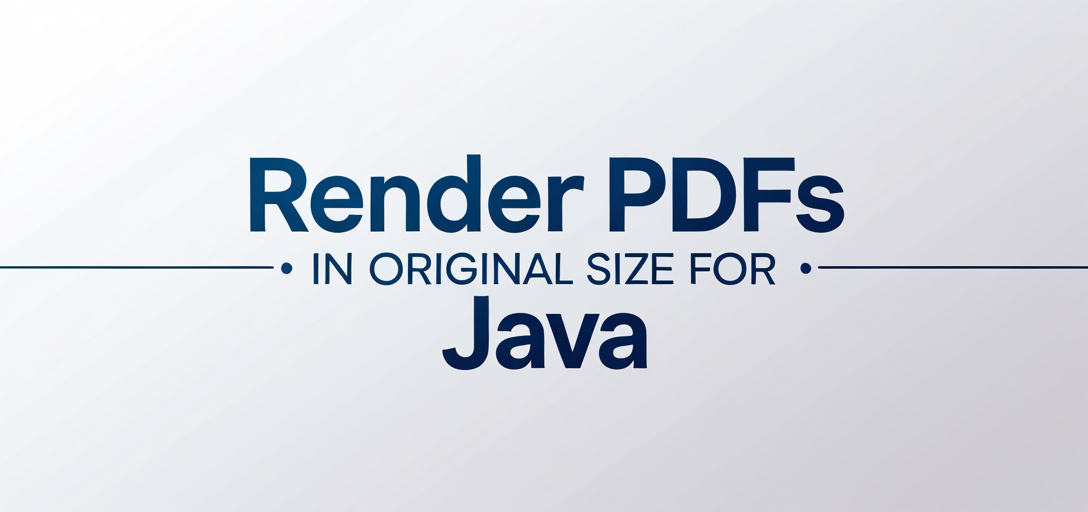How to Render PDFs with Their Original Page Size Using GroupDocs.Viewer for Java
Rendering a PDF while maintaining its original page size is essential for accurate display across various platforms and devices. This comprehensive guide will walk you through implementing this feature using the GroupDocs.Viewer for Java API. By following these steps, you’ll ensure your PDFs retain their fidelity during rendering.

What You’ll Learn
- Why preserving original page size in PDF rendering is important.
- Setting up and configuring GroupDocs.Viewer for Java.
- A detailed step-by-step guide to render PDFs with their original dimensions.
- Practical applications and integration possibilities.
- Techniques for optimizing performance during this task.
Let’s review the prerequisites you need before getting started!
Prerequisites
To follow along, ensure you have:
- Java Development Kit (JDK): JDK 8 or above must be installed on your machine.
- GroupDocs.Viewer for Java: Integrate this library using Maven.
- IDE: Use an Integrated Development Environment like IntelliJ IDEA or Eclipse.
Setting Up GroupDocs.Viewer for Java
To start, set up the GroupDocs.Viewer for Java in your development environment. This process is straightforward if you use a build tool like Maven:
Maven Configuration
<repositories>
<repository>
<id>groupdocs-repo</id>
<name>GroupDocs Repository</name>
<url>https://releases.groupdocs.com/viewer/java/</url>
</repository>
</repositories>
<dependencies>
<dependency>
<groupId>com.groupdocs</groupId>
<artifactId>groupdocs-viewer</artifactId>
<version>25.2</version>
</dependency>
</dependencies>
License Acquisition
GroupDocs offers various licensing options:
- Free Trial: Begin with a free trial to explore features.
- Temporary License: Obtain a temporary license for full access without limitations.
- Purchase: Consider purchasing if your project requires long-term use.
Implementation Guide
Now, let’s focus on implementing PDF rendering while preserving the original page size. We’ll guide you through each step in detail.
Initialize GroupDocs.Viewer
Overview:
Begin by setting up a Viewer instance for your source document.
import com.groupdocs.viewer.Viewer;
import com.groupdocs.viewer.options.PngViewOptions;
import java.nio.file.Path;
public class RenderOriginalPageSize {
public static void main(String[] args) {
// Define output directory path for rendered pages
Path outputDirectory = Path.of("YOUR_OUTPUT_DIRECTORY");
// Format for the output page file paths
String pageFilePathFormat = "page_{0}.png";
Path pageFilePath = outputDirectory.resolve(pageFilePathFormat);
// Initialize PngViewOptions with the path format
PngViewOptions viewOptions = new PngViewOptions(pageFilePath.toString());
// Set option to render original page size for PDF documents
viewOptions.getPdfOptions().setRenderOriginalPageSize(true);
// Create a Viewer instance for the source PDF document
try (Viewer viewer = new Viewer("YOUR_DOCUMENT_DIRECTORY/SAMPLE_PDF")) {
// Render the PDF using the specified options
viewer.view(viewOptions);
}
}
}
Explanation:
- Path Configuration: Define where the rendered images will be stored.
- PngViewOptions: Specify that we want PNG output and configure path formatting for each page.
- Render Original Page Size: This crucial setting ensures pages are not scaled, maintaining their original dimensions.
Troubleshooting Tips
If you encounter issues:
- Ensure paths in
outputDirectoryand"YOUR_DOCUMENT_DIRECTORY/SAMPLE_PDF"are correct. - Verify GroupDocs.Viewer is correctly configured in your build tool.
Practical Applications
Rendering PDFs with their original page size can be beneficial for various scenarios, including:
- Digital Archives: Preserve the integrity of historical documents for archival purposes.
- Legal Document Management: Ensure legal documents maintain their layout when viewed digitally.
- Educational Material Sharing: Share textbooks or instructional materials without altering content structure.
- Invoice Processing Systems: Maintain consistency and readability in automated invoice processing systems.
Performance Considerations
Optimizing the performance of PDF rendering is crucial, especially for large documents:
- Memory Management: Allocate sufficient memory to handle large files efficiently.
- Lazy Loading: Load only necessary pages or sections when dealing with extensive documents.
- Caching Mechanisms: Implement caching for frequently accessed PDFs to reduce processing time.
Conclusion
By following this guide, you’ve learned how to use GroupDocs.Viewer for Java to render PDFs while preserving their original page size. This skill is invaluable in maintaining document integrity across various applications.
As a next step, consider exploring additional features of GroupDocs.Viewer, such as watermarking and conversion capabilities.
FAQ Section
1. How do I integrate GroupDocs.Viewer with other frameworks like Spring?
- You can use dependency injection to manage Viewer instances within your application context.
2. Can I render PDFs in formats other than PNG?
- Yes, GroupDocs.Viewer supports multiple output formats including JPEG and SVG.
3. What should I do if the rendering process fails?
- Check error logs for specific messages and ensure paths are correctly specified.
4. Is there a limit to the size of PDF files that can be rendered?
- Performance may degrade with very large files, so consider splitting them into manageable sections.
5. Can I render encrypted PDFs directly?
- GroupDocs.Viewer supports rendering of protected documents if you provide necessary credentials.
Resources
For further reading and resources:
- Documentation: GroupDocs Viewer Java Docs
- API Reference: GroupDocs API Reference for Java
- Download GroupDocs.Viewer: Official Downloads
- Purchase and Licensing: Buy GroupDocs Products
- Free Trial: GroupDocs Free Trial
- Temporary License: Get Temporary License
- Support Forum: GroupDocs Support Forum
We hope this guide helps you implement PDF rendering with original page size using GroupDocs.Viewer for Java. Happy coding!